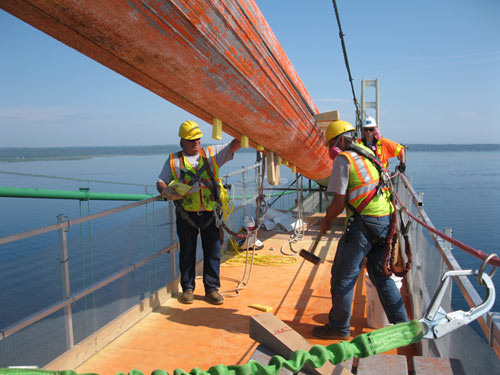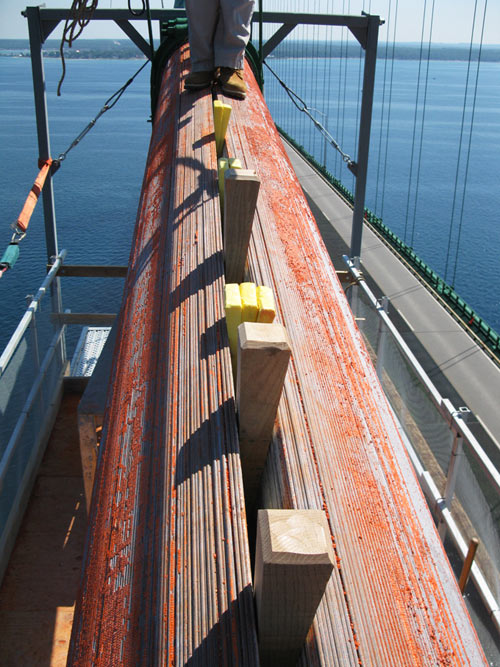Pristine Mackinac Bridge cables holding up nicely
Date Posted: November 1 2013
ST. IGNACE - Rain, snow, sleet, hail, ice, sunshine, high winds, hot and cold temperatures – the Mackinac Bridge has had just about everything thrown at it since it opened to traffic 56 years ago Nov. 1.
And thanks to a good design, quality original construction and ongoing maintenance, the span today is no less able to withstand all of Mother Nature's repertoire. The latest evidence of this took place this summer, when Mackinac Bridge Authority maintenance crews and a consultant “unwrapped” and inspected portions of the twin 24-1/2-inch diameter main cables from which the bridge deck is suspended. Each main cable is comprised of a bundled-together mass of 12,580 galvanized wires.
"We were looking for signs of pitting and corrosion, especially at the bottom of the cables,” said Bob Sweeney, secretary of the Mackinac Bridge Authority. “What we found is that 99.7 percent of the wires were in mint condition, like the day they were put down. The galvanizing was not at all compromised."
The Mackinac Bridge Authority inspects 12 main cable locations on the bridge during the course of a decade, in addition to the other areas of the span that it inspects. The cable inspection work is done by a crew of three or four, with input from consultant Parsons Transportation Group. This summer three areas of the main cable were inspected. The inspections can take several weeks.
The anti-corrosive benefits of galvanizing the steel strands was a process available to the bridge designers when the Mighty Mac was completed in 1957. Sweeney said the original cables were also coated with a red lead paste that is still present. The modern covering of the main cables involves the application of noxide epoxy paint, a flexible material which can be “peeled off like a rubber sheet,” Sweeney said.
The inspection process involves the placement of wedges separating the cable strands at 3-, 6-, 9- and 12-o’clock positions to allow for deeper inspection of the cables. The crew opens up 40-foot sections of cable, which are inspected on site, with plenty of photos taken.
When the inspection is complete, a zinc paste is applied to the exposed cables, and a “compactor” puts the squeeze on the cables to get them back into the original diameter. Then a green coat of noxide epoxy paint is applied, and the work of the inspectors is done.
Sweeney said around the country, the condition of aging cable-suspended bridges is a “major concern” for their owners, especially those that exist in a salt-water environment or haven’t had the rigid inspection processes and upkeep that the Mackinac Bridge has had.
“We’re reaping the benefits of a good design, excellent construction with very tight standards and dedicated crews doing maintenance work over the years,” he said. Federal inspections of the Mighty Mac take place every two years, but Sweeney said the Mackinac Bridge Authority – which employs about 100, half of them working maintenance – continuously inspects the span. However, he said it’s a popular misconception that the bridge is being painted continuously from one end to the other. “It’s an urban legend that we go back and forth painting, although we have crews constantly out there painting, working on the road deck and doing steel repairs.”
Patrick “Shorty” Gleason, a member of the Mackinac Bridge Authority, said the Mighty Mac’s good condition is a tribute not only to the original design and construction work, but to the ongoing commitment by the bridge authority to raise tolls when necessary to properly maintain the span. “The bridge is Michigan’s most important structure and is a symbol for the state,” said Gleason, an Iron Workers Local 25 member and legislative director of the Michigan Building and Construction Trades Council. “The state doesn’t necessarily maintain everything well, like our roads, but the bridge is another story.”
Said Sweeney: “The lifespan for the bridge is virtually unlimited. Basically if something wears out, we replace it. And we’re constantly maintaining it. We don’t see an end in sight for the bridge.”

ABOUT 60 FEET ABOVE the Mackinac Bridge’s road deck, Mackinac Bridge Authority workers inspect one of the two main cables on the span. The cables – and the original red lead paste that acted as a preservative – hadn’t seen the light of day since iron workers spun the wires 53 years ago. For more, see the History in the Making article on Page 3.
Photos courtesy Mackinac Bridge Authority

WEDGES SPLIT OPEN the main cable wires, allowing a more thorough inspection.
